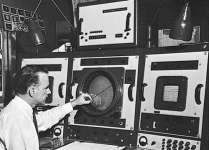WSR-57
Description of the radar set, tactical-technical characteristics

Figure 1: WSR-57
| Specifications | |
|---|---|
| frequency: | 2 900 MHz
(S-Band) |
| pulse repetition time (PRT): | |
| pulse repetition frequency (PRF): | 164 or 545 Hz |
| pulsewidth (τ): | 0.5 or 4 µs |
| receive time: | |
| dead time: | |
| peak power: | 410 kW |
| average power: | |
| instrumented range: | 5 … 125 NM
(≙ 9 … 230 km) |
| range resolution: | |
| accuracy: | |
| beamwidth: | 2° |
| hits per scan: | |
| antenna rotation: | |
| MTBCF: | |
| MTTR: | |
WSR-57
The WSR-57 (Abbr. of Weather Surveillance Radar 1957) was the radar chosen for the first operational weather radar network of the National Weather Service (a local forecast office). It was a classic non-coherent radar and could measure reflectivities only. Its military designator was AN/FPS-41, because the Navy ordered sets of this radar. The WSR-57 was designed in 1957, and operated at S-Band or 10-cm wavelength, chosen to minimize the undesirable effects of signal attenuation by rainfall experienced on the AN/CPS-9 3-cm wavelength radar. The weather warning network was implemented in 1959 with the installation of 31 WSR-57s. By the mid-1960's there were 45 radars around the U.S. in each a distance of around 200 miles.
The first WSR-57 was installed at the Miami hurricane forecast center in 1959. The last WSR-57 radar was decommissioned in Charleston on December 2. 1996.
Bildergalerie von WSR-57
Picture gallery of WSR-57
Galerie du radar WSR-57
Galerie de imagini de WSR-57
WSR-57 Radarın resimleri
Source:
- Roger C. Whiton et al., 'History of Operational Use of Weather Radar by U.S. Weather Services.' Part I: The Pre-NEXRAD Era (Online)

